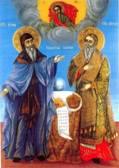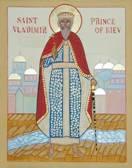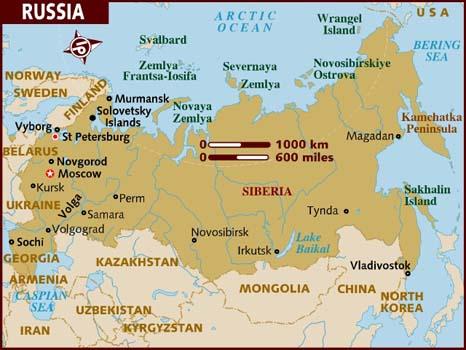Slavic Churches: Cyril and Methodius/Baptism of Russia
UNIT 11: SLAVIC CHURCHES
Objective: Students should be able to identify Sts. Cyril and Methodius, St. Vladimir, St. Olga, St. Alexander Nevsky, St. Innocent, St. Herman of Alaska, St. Peter the Aleut, St. Tikhom, and understand their importance in Russian and American history, the development of the OCA and the Russian Orthodox Churches, and the present organization and leaders of the OCA.
WEEK 1: CYRIL AND METHODIUS/BAPTISM OF RUS
Historical Context
In the west, Roman had fallen to the “barbarians” – Visigoths, Franks, Vandals, etc. The Slavs were the barbarians of the East. Have a map ready to locate these tribes, and the places mentioned later in the lesson. Pushed by the invasions of the Huns (Remember Attila the Hun?), some tribes moved west (becoming Czechs and Poles), some moved north (becoming Russians), but the Balkan Slavs constantly pressed against the Byzantine Empire to the South, occasionally invading the city of Constantinople itself. They were conquered in the 7th century by the Bulgars, a Mongolian tribe, who adopted the Slavic language and formed a powerful kingdom that often came into conflict with the Byzantine Empire. The eastern Slavs were conquered by the Swedish Varangians under their leader, Rurik. Rurik, also called Rus, founded a kingdom with Novgorod as its capital; the people of this new kingdom were called Russians. These new kingdoms were constantly at war with each other as well as with the Byzantines, and shared no part of the Greco-Roman civilization common to the Christian Church until then. Would they even be interested in Christianity?
Cyril and Methodius:
In the city of Thessalonica lived two brothers named Constantine and Methodius.
 They lived about 800 years after the time of Jesus. They had friends who were Greek and friends who were Slavic, from countries to the north who spoke a different language. Some of the Slavs had come as slaves, but had now settled in the city as tradesmen. The Slavic language was heard commonly in Thessalonica. In this city, lived a Christian family with seven highly educated sons, men who were expected to make good careers in the Empire. Methodius, the oldest, a quiet, conscientious man, became governor of a province in Asia; his youngest brother, Constantine, a thoughtful and dreamy boy, went to Constantinople to study with the young Emperor and later to work for the Patriarch defending the veneration of icons. Constantine even spent a period of time in Syria as minister to the Arabs; he had many discussions with the caliph about Christianity. But, soon both brothers decided to become monks.
They lived about 800 years after the time of Jesus. They had friends who were Greek and friends who were Slavic, from countries to the north who spoke a different language. Some of the Slavs had come as slaves, but had now settled in the city as tradesmen. The Slavic language was heard commonly in Thessalonica. In this city, lived a Christian family with seven highly educated sons, men who were expected to make good careers in the Empire. Methodius, the oldest, a quiet, conscientious man, became governor of a province in Asia; his youngest brother, Constantine, a thoughtful and dreamy boy, went to Constantinople to study with the young Emperor and later to work for the Patriarch defending the veneration of icons. Constantine even spent a period of time in Syria as minister to the Arabs; he had many discussions with the caliph about Christianity. But, soon both brothers decided to become monks.
Later the king of the Khazars, in southern Russia, sent a messenger to the Emperor asking for someone to be sent who could tell them about the Christian faith. The people were confused by so many different religions. Some had adopted Islam, and some Judaism. Constantine and Methodius left their monastery and went to Russia along the Dnieper River. There they taught the king all about the Christian faith. Many people were baptized. Finally, the brothers headed back to Constantinople. They went back to their monastery.
The next year, another messenger came, this time from the land of Moravia, to the Bulgarian people. Prince Rostislav there wanted someone to come who could teach the people in their own Slavic language. The emperor immediately thought of Constantine and Methodius, who had learned from their friends in childhood. But, how to teach in the Slavic language? There was no alphabet for the sounds, so Constantine had to make up an alphabet to write down the teachings of Jesus. Then, the brothers wrote down the liturgy and parts of the Bible in the new alphabet. When they got to Moravia, they taught the people to read in their own language and started churches with liturgy in their own language. People flocked to hear the missionaries; the Slavs were truly ready for Christianity.
After several years, the brothers went back to the monastery. Constantine was very sick, and was tonsured a monk and given the name of Cyril. So the alphabet he invented is known to this day as the Cyrillic alphabet. Cyril died soon after, and Methodius went back to the Slavic countries as a bishop. He started more churches and trained Slavic priests. Finally, as an old man, Methodius died, still serving Jesus in the Slavic countries.

Baptism of Russia:
The Varangian Russians were first known as the Kievan state. Kiev stood at the center of river traffic in Russia; merchants faced with the Islamic pirate ships in the Mediterranean found these new routes safer. They brought with them their Christian religion. And the Cyrillic alphabet and Slavonic language infiltrated across their southern borders with Bulgaria. In fact, none of the other barbarian tribes had their own alphabet, written Scriptures, and Liturgy in their own language.
The Russian ruler, Igor, died, and his widow, Olga, became regent for her son Svyatoslav. Olga made a visit to Constantinople in 955 AD and became a Christian and was baptized. But her people were still worshipping gods made of wood. Olga tried to spread Christianity, but not even her son was interested. Svyatoslav married the captive daughter of a great enemy of the Kievan state, Malusha; this enraged Olga, who sent the captive servant away to her native region. There, a son was born to Svyatoslav and Malusha, named Volodomir, or Peaceful Ruler. And, later, when her son was grown and away at wars, Olga cared for her grandson, now called Vladimir. She taught him about Christianity. St. Olga is known as “Equal to the Apostles.” At first, Vladimir rebelled and lived a life of pleasure and sin, while still a pagan. Svyatoslav divided his kingdom before his death in battle between his three sons, with Vladimir inheriting Novgorod in the north, but by peaceful means and battle, Vladimir conquered the entire land.
Vladimir became ruler in 980 AD. He wanted a state religion for the Russian people. Missionaries had come from Islam, Judaism, the Latin Church, and from the Eastern Church. He was not sure what religion was true. So Vladimir sent a group of men to each country to see if its religion was true. The men found beauty and truth in the Christian churches of Constantinople. But, Vladimir was still not sure what was best for his people. Vladimir offered to marry the sister of the Emperors Basil and Constantine. Her name was Anna. Anna did not want to go to Russia, but hoped that she could help the land of Russia to believe in Jesus. Vladimir, meanwhile, had gone blind; he could not see. He was told that he would not see until he was baptized. Vladimir decided this would be a test to prove the true God and was baptized. He was healed!
Now Vladimir wanted his people to know the true faith also. He burned their idols of wood – nothing happened. These were false gods with no power. In 988 AD he told all the people of Kiev, rich and poor, young and old, to meet him on  the banks of the Dneiper River the next morning. Prince Vladimir told them all about Jesus and their need to be baptized. They waded right into the river -- mothers, fathers, children, babies – thousands were baptized that day. Churches were built where once had stood the pagan altars, and the Liturgy was held in the Slavonic language of Cyril and Methodius. A prayer of St. Vladimir at the dedication of the magnificent cathedral in Kiev devoted to the Theotokos is preserved to this day: “O Lord God, look Thou down from Heaven and behold, and visit Thine vineyard, which Thy right-hand hath planted. And make this new people, whom Thou hast converted in heart and ind – to know Thee, the True God. And look down upon this Thy church, which Thy unworthy servant hath built in the name of the Mother Who hath given birth to Thee, She the Ever-Virgin Mother of God. And whosoever doth pray in this church, let his prayer then be heard, on account of the prayers to the All-Pure Mother of God.” In 991 the population of Novgorod was also baptized. By the end of Vladimir’s reign in 1015 AD, there were three bishoprics in Russia, reaching the upper Volga. Even pagan enemies in the far steppes were often defeated not in battle but with baptism! Prince Vladimir is remembered as the “Baptizer of Russia”, equal to the apostles.
the banks of the Dneiper River the next morning. Prince Vladimir told them all about Jesus and their need to be baptized. They waded right into the river -- mothers, fathers, children, babies – thousands were baptized that day. Churches were built where once had stood the pagan altars, and the Liturgy was held in the Slavonic language of Cyril and Methodius. A prayer of St. Vladimir at the dedication of the magnificent cathedral in Kiev devoted to the Theotokos is preserved to this day: “O Lord God, look Thou down from Heaven and behold, and visit Thine vineyard, which Thy right-hand hath planted. And make this new people, whom Thou hast converted in heart and ind – to know Thee, the True God. And look down upon this Thy church, which Thy unworthy servant hath built in the name of the Mother Who hath given birth to Thee, She the Ever-Virgin Mother of God. And whosoever doth pray in this church, let his prayer then be heard, on account of the prayers to the All-Pure Mother of God.” In 991 the population of Novgorod was also baptized. By the end of Vladimir’s reign in 1015 AD, there were three bishoprics in Russia, reaching the upper Volga. Even pagan enemies in the far steppes were often defeated not in battle but with baptism! Prince Vladimir is remembered as the “Baptizer of Russia”, equal to the apostles.
Play a Learning Game: Cyrillic Alphabet Code --St. Cyril made a whole new alphabet for the Slavic people, now known as the Cyrillic alphabet. It is still used today in Russia and many Slavic countries. While to learn Russian would be a huge task, to become familiar with the alphabet, as an Orthodox Christian, is critical. Wouldn’t it be nice to be able to sound out the names of the saints on the icons in a Russian church? Look at the alphabet on the next page. Put a copy on the board or make a copy for each student. Sound out each letter as if it were a secret code. Then sound out the message at the bottom. Can each of you also write a short message in the Cyrillic alphabet for your classmates?
Primstav: Add Sts. Cyril and Methodius on May 11, and St. Vladimir on July 15.
 Close with Prayer.
Close with Prayer.
